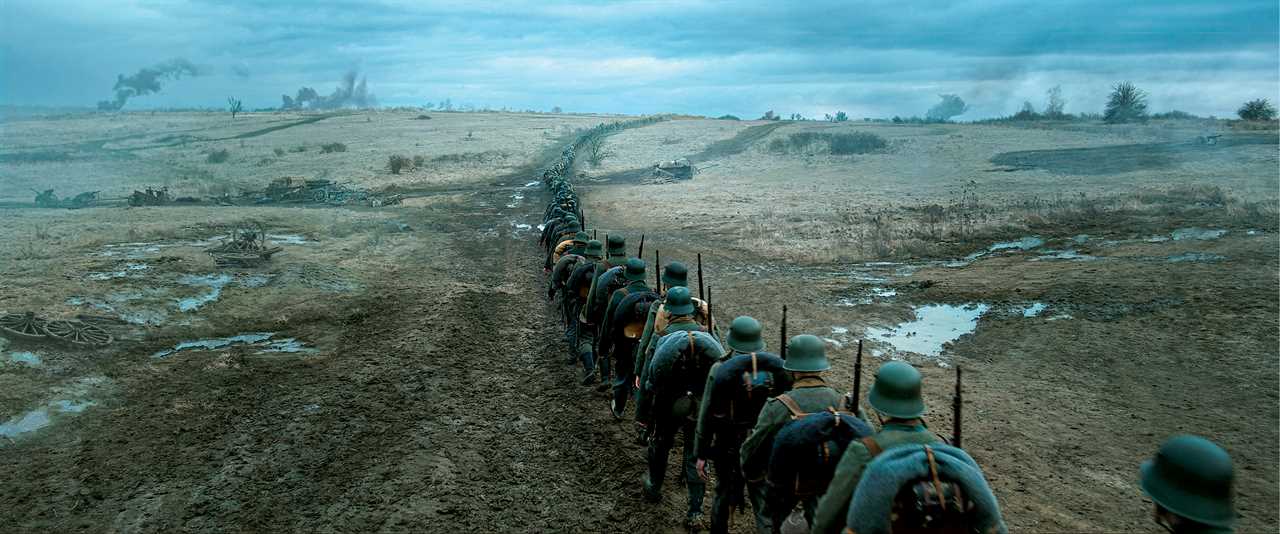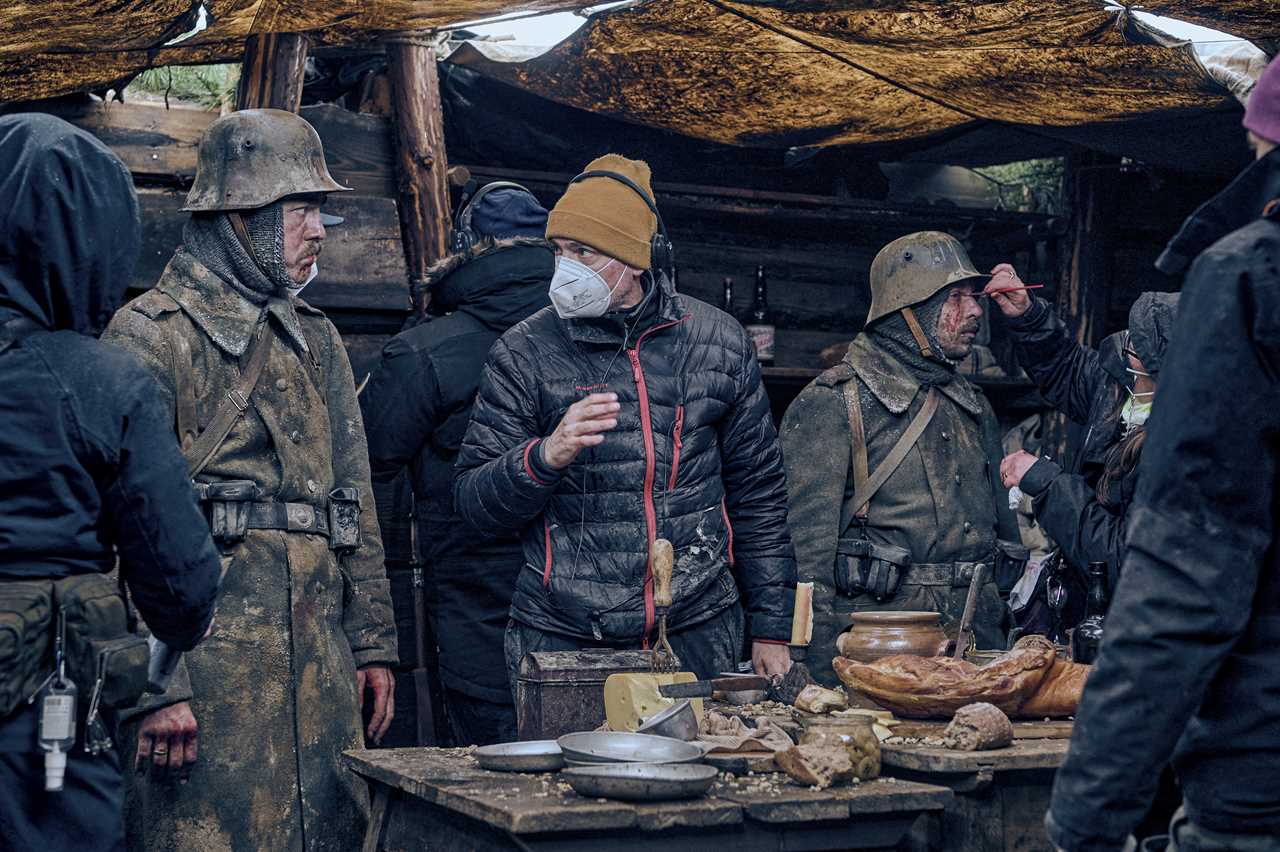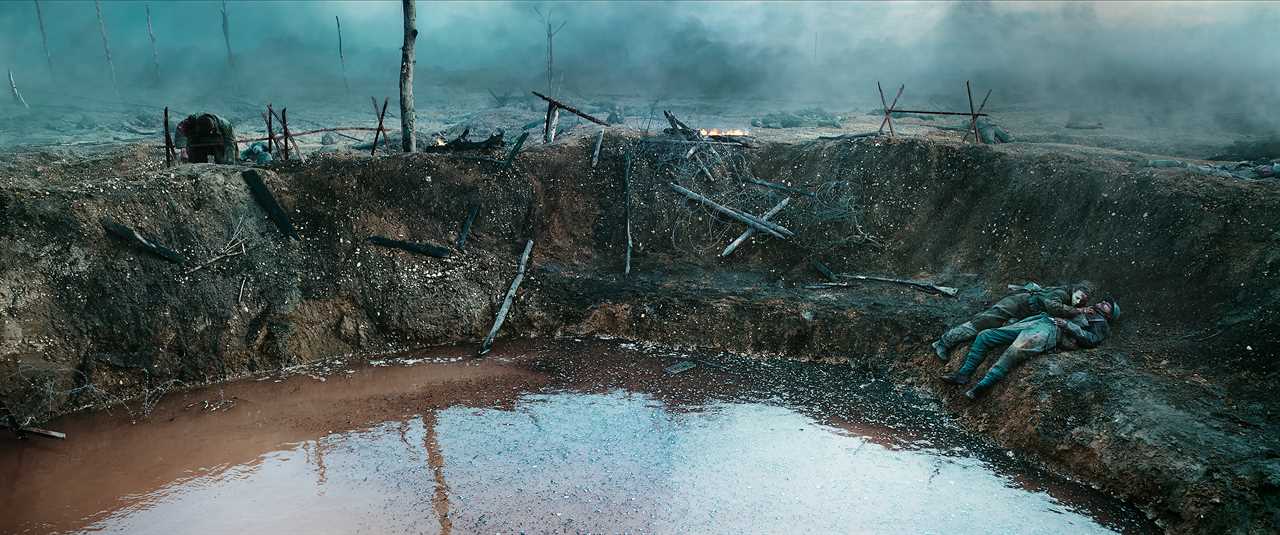“All Quiet on the Western Front” came out of the BAFTAs with seven wins, including Best Film and Best Director, and boasts nine Oscar nominations. With the influential international Academy voting bloc, could this win Best Picture?
Foreign-language Best Picture wins are still rare, especially without the directing nod that “All Quiet” lacks. Bong Joon Ho won Best Director and Best Picture with “Parasite” in 2020, and it remains an anomaly. The Korean crowd pleaser grossed $252 million worldwide and also won the SAG Ensemble award that went to 2022 Oscar winner “CODA” and 2023 frontrunner “Everything Everywhere All at Once.”
Still, grabbing a Best Picture nomination shows how competitive “All Quiet on the Western Front” could be in many categories and Netflix’s formidable awards machine is now focused on its strongest contender, from Best International Feature, Adapted Screenplay, and Cinematography to Production Design, Sound, and Score.
Over a wide-ranging conversation, Swiss director Edward Berger, speaking on Zoom from London, delved into the many ways the director of such series as “Patrick Melrose” and “Deutschland 83” turned this German-language World War I adaptation of Erich Maria Remarque’s 1928 novel into a must-see war drama.
He had to contend with a limited budget (his official quote is “around” $20-million) for a sprawling period picture shot in 54 days during Covid. He also had to face his own ambitions and fears as he fought for challenging shots amid the muddy wet chill of spring in the Czech Republic. Faced with the occasional panic attack, British cinematographer James Friend (also a BAFTA winner) kept him going.
“What was complicated is trying to make a movie of this size with this epic feeling and length for that little money,” said Berger. “We could only do it by planning very diligently every single frame and knowing what we needed for that frame.”
1. Adapt a known entity. The anti-war book, which Hollywood director Lewis Milestone turned into a Best Picture winner in 1930, is still a bestseller in Germany, partly because it’s required reading in schools. For some 70 years it has sold from 50,000-70,000 copies a year, said Berger.
2. Listen to your kids. The English-language script from Lesley Paterson and Ian Stokell kicked around for 10 years until producer Daniel Marc Dreifuss (Oscar-nominated “No”) realized it would never come together as a Hollywood project and sent it to German producer Malte Grunert (Oscar-nominated “Land of Mine”). Berger brought it up with his family and was surprised when his 17-year-old daughter said, “‘All Quiet on the Western Front’? You have to do it. I just read it. It’s a book that had a massive effect on me. And I cried many times, and you have to make it.”
Said Berger, “That really left me no choice. I read it when I was 17. And again, in my 20s. And when I rewrote the script. And it’s always stayed with me. It has to do with our history, too, that’s ingrained in the culture. You automatically think back on what you’ve inherited. You think of the complete senselessness of these armed conflicts and you feel angry and guilty and shameful about it.”

“All Quiet on the western Front”
Courtesy of Netflix
3. Heed the source material. Berger was born in Germany, raised in Switzerland, and lived in Berlin since 1997. As he adapted the screenplay, he kept some things and added others, but hewed to the observational style that one-time reporter Remarque adopts in telling the story. “What’s beautiful about the tone of the book, it’s almost laconic,” he said. “The way he describes things is matter of fact, not over-emotional, like, ‘This is what happens to the kids.’ They become detached from their emotions, from their souls. They have to, otherwise they’d die inside. [Remarque] stays away from feeling and emotion very much. Therefore, you bring your own. We tried to retain that with the camera, which goes subjectively through the film with Paul.”
4. Aim at a wide audience. As he overhauled the English script, Berger made it more German. “We know what Germany brought into the world,” said Berger.”You live with that heritage, try to deal with it responsibly, and try to change the world one bit at a time by not perpetuating that type of hatred. It’s specifically German. It’s mainly a feeling that you put into the scenes, a tonal shift that takes it away from American storytelling towards a specific German storytelling. I felt that the script was very American. We don’t need that one. There are many American war films and the Americans are much better at telling them that way. And so if I need to do it, we have to make the German version. I needed to change that perspective.”
The goal was to reach an international audience, not just a German one. Much debated in Germany were Berger’s additions to the original narrative — including the armistice negotiations between France and Germany, which pushed back the original book’s timeline to the last five days of the war. But clearly the film resonated outside Germany, especially in the U.K. and in America.
5. Open your movie with a bang. The opening sequence is a bravura shot that throws the viewer into the trenches. The long, complicated take required three weekend days of blocking and rehearsal for the camera crew, stunt people, and actors. The camera goes through the trenches and lands on a soldier’s face before he charges over the top of the trench, finds a tree trunk, and hits an enemy soldier with a shovel.
“The camera is carried on a stable eye like a pole,” said Berger. “Then you hang it on a crane, the crane pulls up the camera as the guy climbs out of the trench, then you need a second to take the camera off again, because the crane can’t go as far as the guy is going to run, so the two grips can grab the camera and run next to this guy. In these seconds, you need to coordinate the camera for it to go off on the crane: It takes three, four seconds. So if the guy climbs out of the trench and starts running, he’s gone. If you watch it again, we created a diversion for the character that lets him pause and the diversion is an explosion. And he ducks and is scared and this is the time for the grips to get the camera out of the crane. Then the guy starts running and they can follow him.”
Friend pulled off some stunning shots, but Berger believes in restraint. “None of us can show off,” said Berger. “It’s about the actor’s face. And what he is inside the stomach. Everything is there to express what he’s feeling. We are background noise.”
Sound is also crucial. When the soldier dives behind a tree trunk into an explosion zone, German sound designer Frank Kruse and his team created a muffled soundscape. “They actually recorded microphones that they dragged through the mud and put that in the film as a metaphor for the mud that these guys are trying to avoid to become again, like the earth they’re going to turn into,” Berger said. “When you hear that, it sounds earthy and muddy and wet and we give you the feeling of being there. When we record sound, I tell the actors often, especially when they run, to give you that breath so you have the feeling that you run with them.”
After the soldier dies, a nurse removes his uniform that we follow to the laundry, seamstress repair, and onto the lean frame of eager recruit Paul (theater discovery Felix Kammerer). “The essence of the book for me is how young people get pulled into a conflict, pulled into war, egged on by nationalistic hate speech,” said Berger. “They become ground up in this war machine. They lose their souls and become killing machines, they lose their youth and innocence, they lose everything. And they become these dispensable things that are mauled up in the war machine. We tried to create this montage of the war machine and express in the first five minutes what the movie is about.”

“All Quiet on the Western Front”
Courtesy of Netflix
6. Change things up. Given the grisly trench mire, it was crucial that Berger pull back occasionally and let the audience breathe. He used Friend’s nature shots “to give you the moments of peace or pockets of quiet as a counterbalance to give our ears, eyes, and minds a rest and also a yearning. We see all this destruction and it makes us cringe, and it’s not pleasant to watch. And then you look over there and you see the nature and the beauty and the foxes and the warmth and the family and the place you want to go back to, yah? That we lose when we leave our homes or the womb and that we’re in search of our entire life. You want to preserve that, and then at the next moment that is yanked away from you, to make [the contrast] even more painful.”
Berger’s research into wartime letters revealed the men spent some 10 grueling days in the trenches, sleeping there, followed by R&R. “It became evident how much fun they wanted to have too, because the rhythm of the war was always they were sent to the front and then they were sent back to behind the lines and the other regiment came. They had probably a week of rest and it was really a holiday camp. They drank and they played games, they had fun.”
The two actors improvised the scene near the end when the soldiers run up to the gates of the farm when it’s snowing. “They chase each other and they laugh,” said Berger. “Every time we have the opportunity to smile or to laugh, we should grasp that and put that in the film. Because every smile, it’s like a relief.”

“All Quiet on the Western Front.”
Courtesy of Netflix
In one tour-de-force sequence, the German soldiers break through the French lines and enter their bunkers to discover a spread of baguettes, sausages, cheese, and honey. They dig in with fervor. “That scene in the French trench came from the book,” said Berger. “It’s not described as we’ve shot it. It says that the French always had better food. And whenever they went there, they tried to eat as much as they could. This part, what I said to the actors, is about hunger for life in the face of death. You devour, you get a chance, a sniff of the whiff of life and you go, ‘Oh, I want to eat it. And I don’t ever want to let it go.’ As beasts of survival, the only goal is to survive and surviving in this conflict and war means eating and killing. Because if you don’t kill, then you will be killed.”
When the soldiers are in the bunker before it collapses, “I looked at the images while I was sitting in the sound design studio with the sound designer,” said Berger. “I thought, ‘This is like claustrophobia, this is ‘Das Boot’ the movie, let’s get inspiration from that.’ They put in all these creaking wooden beams and every second you have the feeling ‘Oh, this thing is gonna collapse.'”

“All Quiet on the western Front”
Courtesy of Netflix
8. Don’t panic. One shot at a time. Many days, Berger didn’t think he’d make his shot list. “The scene that probably was the most challenging was the tank scene,” he said. “I thought I’d never get through it and we’d get crushed by those tanks. I really broke down sometimes in the car on the way home. The cinematographer pulled me up and said, ‘Let’s just take one shot at a time and then we’ll get through it.’ It helped us; we had these storyboards and did them from shot to shot.
“The shots infuse you with panic, because the first 10 takes are just terrible,” he said. “They just don’t work and you’re close to giving up. You think, ‘I already wasted three hours on the shot or actually four days, and now three hours on this day, and it doesn’t work, and then we’re never ever gonna get it.’ When we just somehow got it, it’s such a relief. It’s an incredibly good feeling.”
The most psychologically challenging sequence was the centerpiece crater scene when Paul kills the French soldier, which Berger restored to the screenplay after his daughter identified it as the best and most gruesomely moving in the book. The scene was three pages in the script, but the scene took 12 minutes at the first rehearsal with Kammerer and the stuntman. “The [assistant director] asks, ‘Can you simplify the scene?’ Because we’re going to need four days if you don’t.'”
Berger would not simplify it, or as he said: “I had to shut the A.D. ear and I listen to my daughter.”
In the scene, Kammerer holds a real (dull) knife and then a fake one to stab the soldier as blood pumps out of his uniform. “Then Paul takes a handful of mud and stuffs the soldier’s mouth with it and he tries to suffocate him. You dig out a hole and put edible clay in there that looks like mud and you stuff that in his mouth. It’s so many different camera angles, and moments and beats that if you don’t film them, they’re going to be lost. We shot up to the moment when Paul wakes up and listens to the birds, which for me was important because it’s the sound of peace. The swifts are flying over him and he listens and suddenly wakes up and he’s just killed a man. And he walks away.”
Those three and a half days were tough on Kammerer, who soaked up 90 pounds of water weight in his felt uniform. “Felix sits there in the mud and just cries for four days straight and it’s cold and he just gives everything to every shot,” said Berger. “When he did it, I remember him telling me that he heard this noise and he realized that the camera operator was crying while he filmed him. And it’s a British camera operator. We filmed this in the Czech Republic, and the grandfather of this camera operator had been in the Second World War and had brought him up to hate the Germans because of what he had been through in the war.”
Next up: After Berger finishes shooting Vatican pope election thriller “Conclave,” based on the Robert Harris novel and starring Ralph Fiennes, he wants to make a different kind of movie.
When he couldn’t find any music to put over the “All Quiet” end credits, “no music fit, it always felt like an interference to your or my emotional experience,” he said. “I just wanted to let you alone with those feelings and not influence you, just silence. But while I was doing it, I was thinking: ‘You know what I want to do: I really want to make a movie where I can put a pop song in the end. The audience gets up, the house lights turned on, and they go: ‘That was just really fun.'”
-----------------------
By: Anne Thompson
Title: Inside the Panic of Making ‘All Quiet on the Western Front’
Sourced From: www.indiewire.com/2023/02/all-quiet-on-the-western-front-interview-director-edward-berger-1234813188/
Published Date: Tue, 28 Feb 2023 22:30:40 +0000






